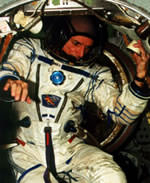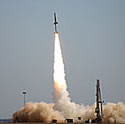A team of Canadian private rocket builders announced their astronaut selection today, as part of their preparations to launch the Canadian Arrow – a ship based on the original V2 design used in World War 2. The six astronauts include three pilots, an aerospace engineer, a Ukrainian astronaut (who was a backup for a 1997 space shuttle mission), and a 28-year old who has the potential to be the youngest astronaut ever. The Canadian Arrow is considered one of the front-runners to win the X-Prize, which gives $10 million to the first private group to place a three-person team in space.
Soyuz Tourist Flights Beginning Soon

Image credit: Space Adventures
Two space tourists will have a chance to fly to the International Space Station in 2005, at a cost of only $20 million each. The flight will include a professional cosmonaut pilot and launch on board a Soyuz rocket from the Baikonur cosmodrome in Kazakhstan. The mission is being organized by Space Adventures, the company that organized the flights for Dennis Tito and Mark Shuttleworth. The Soyuz will completely self-sufficient, providing all the supplies required by the passengers and even some additional supplies for the station.
Commercial space flight took a giant leap forward today with the announcement by Space Adventures, Ltd., the leading space experiences company, of its plans to launch the world’s first privately funded mission to the International Space Station (ISS). Space Adventures recently secured a contract with the Russian Aviation & Space Agency (RASA) to fly two explorers to the ISS aboard a new Soyuz TMA spacecraft.
The mission, Space Adventures-1 (SA-1), continues the company’s record of opening the space frontier to explorers other than government astronauts and cosmonauts. The company brokered the flights for the world’s first private space explorers, American businessman Dennis Tito in 2001, and the first African in space, Mark Shuttleworth, in 2002. SA-1 has the potential to establish several world records, and also marks the first private mission to the International Space Station.
Space Adventures seeks candidates fascinated by one of life’s greatest experiences and who support the exploration of space to participate in the expedition. First “space tourist,” Dennis Tito said, “Private space exploration is an important investment into humanity’s future. Commercial human space flight and space tourism are creating the 21st century technologies and economy that will bring the benefits of space to people on Earth. Helping to make that happen is very meaningful. And of course, being in space itself is a truly blissful experience that I am unable to describe in words, it was worth far more than its cost; truly priceless.”
Space Adventures has established this mission through its longstanding partnership with RASA and Russia’s leading aerospace company, RSC Energia. “We are pleased to provide the means for this Space Adventures’ mission and are equally committed to the future of private space travel,” says Sergey Gorbunov, Press Secretary for the Director General of RASA. SA-1 participants will train in Star City, the cosmonaut training center outside of Moscow, familiarizing themselves with the Soyuz TMA spacecraft, experiencing weightlessness in a zero-gravity jet, and learning how to live and operate aboard the ISS. The mission is planned for liftoff in early 2005 from the Baikonur Cosmodrome in Kazakhstan and seats aboard the Soyuz are available for $20 million each. Gorbunov also stated, “In the future, we intend to carry out additional private missions to ISS in cooperation with Space Adventures.”
Space Adventures’ CEO, Eric Anderson, remarks, “After the loss of Columbia, the President said that our journey into space must go on. The advancement of commercial space flight and space tourism should and will continue, to everyone’s advantage. And, this mission in particular has been designed to provide great benefit to all parties, not only for the explorers who fly, but also to the ISS program as a whole.” Anderson emphasized that SA-1 will be self-sufficient, bringing its own food, water and medical supplies and that it may transport supplemental supplies for the resident crew aboard the ISS.
The announcement was made at the renowned Explorers Club in New York City on June 18. Accompanying Anderson at the event were Tito, Shuttleworth, and Gorbunov.
In addition to orbital flights to the ISS, Space Adventures, the world’s leading space flight experiences and space tourism company, offers a wide range of programs, from zero-gravity and Edge of Space flights, cosmonaut training and space flight qualification programs, to reservations on future sub-orbital spacecraft. Headquartered in Arlington, VA, with an office in Moscow, Russia, Space Adventures is the only company to have successfully launched private individuals to the International Space Station. The company’s advisory board comprises Apollo 11 moonwalker Buzz Aldrin; shuttle astronauts Kathy Thornton, Robert (Hoot) Gibson, Charles Walker, Norm Thagard, Sam Durrance and Byron Lichtenberg; and Skylab astronaut Owen Garriott.
Original Source: Space Adventures News Release
40 Years After the First Woman in Space
Officials from the Russian Space Agency marked the 40th anniversary of the first woman to travel to space by presenting nine new astronaut candidates. Valentina Tereshkova made a three-day flight into space in 1963 – only two years after Yuri Gagarin became the first man in space. Tereshkova, now 66, did feel sick during her flight, but got controllers to agree to let her spend an extra two days in space. Russia’s new recruits, the first in six years, include four military pilots, three engineers, a physicist and a doctor.
Space Pioneer Unveils Rocket Prototype
Aerospace pioneer Bart Rutan has created what he calls the world’s first private space program. The three-person capsule, rocket and launch aircraft, together dubbed SpaceShipOne, were unveiled at Scaled Composite’s facilities in California on Friday to several hundred guests. Rutan and his team plans a series of test flights culminating at an attempt to win the X-Prize (the first privately built spacecraft to reach space).
Russians Say Bass is Back in Training
Pop singer Lance Bass is getting closer to getting his chance to fly in space according to an announcement from the Russian Space Agency on Friday. Bass, 23, will fly to Houston around the end of August where he will receive training from NASA. Although he is backed by a consortium of companies for the trip, no part of the $20 million fee has been paid yet – the Russians are expecting at least a deposit by the end of this week. If all goes well, Bass will join a Soyuz crew in October to visit the International Space Station for a week. He would become the youngest person ever to fly in space.
Canadian X-Prize Entrant Moves Closer to Spaceflight
A Canadian team competing to win the $10 million X-Prize announced that they had completed a major milestone on their entrant, the Canadian Arrow. The team performed a successful test burn of their prototype engine and believe it will now work in actual flight – a main engine test could happen as early as August. Twenty one teams from 5 countries are competing for the X-Prize, which will award $10 million to the first group able to launch a three-person rocket twice in two weeks to an altitude of 100 km.
Scramjet Prototype Has a Successful Flight

Image credit: University of Queensland
A new jet designed to travel more than 7 times the speed of sound has been successfully tested in the Australian desert. The prototype Hyshot engine is a scramjet; unlike a traditional chemical rocket which carries heavy liquid oxygen in gigantic fuel tanks, a scramjet pulls the oxygen it needs from the atmosphere. The engine was strapped to a traditional rocket and lifted up to an altitude of 300 km at which point the scramjet kicked in and accelerated it towards the Earth – hopefully reaching a speed of 8,600 km/hour before it crashed.
University of Queensland researchers say the launch of the HyShot experiment at the Woomera Prohibited Range today was successful.
?So far it has all gone to plan. The launch was a success, and we received data for the duration of the flight,? said HyShot program team leader Dr Allan Paull.
The aim of the experiment is to achieve the world`s first flight test of air-breathing supersonic ramjet engines, also known as scramjets. These engines could revolutionise the launch of small space payloads, such as communications satellites, by substantially lowering costs.
Today?s launch of a Terrier Orion Mk70 rocket fitted with a scramjet engine took place at 1135 local time (1205 AEST).
Dr Paull said although the signs so far have been positive, it is still too early to say the scramjet experiment has succeeded. The scramjet experiment took place within only the last few seconds of the flight, lasting almost 10 minutes.
?Hopefully we?ll be in a better position to make that assessment in the next couple of days, but at the moment I?m feeling confident,? he said.
?Nevertheless, even at this early stage we have achieved what no else has managed to do, helping put Australia at the forefront on this new technology.
?I would like to thank all consortium partners, in particular the Aircraft Research and Development Unit, Australian Defence (ARDU) and the Defence Science and Technology, Organisation (DSTO).?
Other consortium partners include Astrotech Space Operations, DTI and GASL, QinetiQ, NASA Langley Research Center, Seoul National University, the DLR (German Aerospace Center), NAL (National Aerospace lab. Japan), AFRL (Air Force Research Laboratory, USA), Australian Space Research Institute (ASRI), Institute of Engineers Australia (IEAust), UniQuest and the Australian Department of Defence.
Australian firms, Alesi Technologies, NQEA, AECA, Luxfer Australia and Jet Air Cargo, and BAE Systems Australia are also involved.
Original Source: UQ News Release
Solar Flare Silences Japanese Mars Probe
A solar flare has struck Nozomi, Japan’s first probe to Mars, cutting off its communications with Earth. Japanese scientists believe that the spacecraft can repair the damage within 6-months, hopefully before it arrives at the Red Planet in December 2003. The solar flare happened over a month ago, but the damage to the spacecraft was only recently admitted to the public. Nozomi will study Mars’ upper atmosphere and magnetic field.
Families Might Make the Best Spacefarers
According to John Moore, a University of Florida anthropologist, families might have the right social dynamic to take on long duration space voyages – such as the colonization of another star, which could take 200 years to reach. By organizing the crew along family lines, Moore believes a crew would be better protected from problems that could occur over a multigenerational journey. In fact, in order to have enough genetic diversity to seed a new plant, Moore believes you only need a starting population of 150-180 people.
